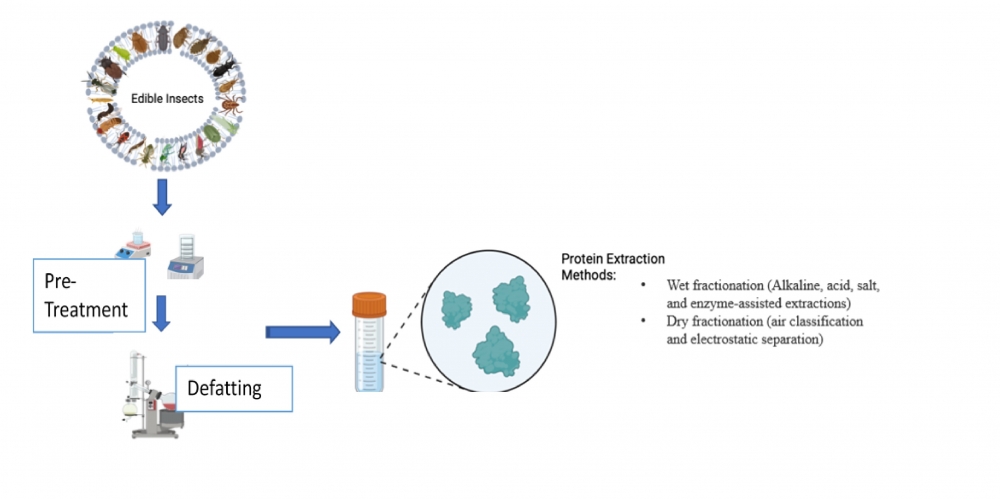JOURNAL 2976
Records of Agricultural and Food Chemistry
Year: 2024 Issue: 3 Special Issue: Abstracts 3rd. TCS, International Food Chemistry Congress February 29-March 03,2024 Antalya Türkiye
p.12 - 12
Viewed 2230 times.
GRAPHICAL ABSTRACT

ABSTRACT
In response to the recent growth in the global population and the resulting scarcity of protein resources, there is a pressing need to develop novel, sustainable, and natural sources of protein from invertebrates, including insects. Edible insects represent valuable sources of protein (35-62%), fat (3-57%), and chitin (3-12%). The main protein components found in insects consist of albumin, globulin, and glutenin. Protein extraction methods from these insects can be classified into various groups, including wet and dry fractioning, solvent extraction (alkali, acid, and salt), enzyme extraction, and physical methods. Wet fractioning processes encompass alkali extraction, acid extraction, salt extraction, and enzyme-assisted extraction, while dry fractioning methods involve air classification and electrostatic separation. In addition to these techniques, innovative green methods such as ultrasound, pulsed electric field, and supercritical CO2 extraction can be employed for protein extraction. To extract protein from edible insects, pre-steps such as harvesting, washing, inactivating, drying, and defatting are carried out. Alkali extraction, using NaOH as a solvent, is a commonly utilized method, particularly after defatting. While effective, alkali extraction may lead to reactions in the protein backbone, causing denaturation, hydrolysis, racemization, and the formation of cross-linked molecules like lysinoalanine, resulting in decreased functionality and nutritional value. Other approaches, such as stepwise protein extraction (including aqueous extraction, salt extraction, alcohol extraction, alkali extraction, etc.) and enzymatic hydrolysis (utilizing enzymes such as papain, protease, pepsin, pancreatin, etc.), can also be employed. Enzymatic hydrolysis requires specific conditions for each enzyme, and although its yield is lower than solvent extraction, it remains a viable method. Proteins obtained from edible insects demonstrate antioxidant, anti-diabetic, anti-hypertensive, anti-cancer, anti-microbial, anti-inflammatory, and immunomodulatory properties. In addition to health benefits, insect proteins exhibit diverse functional characteristics, including the ability to create foam, emulsify, and gel. The extracted protein from edible insects finds applications in various industries, including animal feeds, pet foods, human foods, cosmetics, and more. This review aims to explore protein extraction methods from edible insects and discuss the potential applications of the obtained extracts [1-4].
KEYWORDS- Edible insect
- protein extraction
- enzyme extraction
- antioxidant
- animal feed